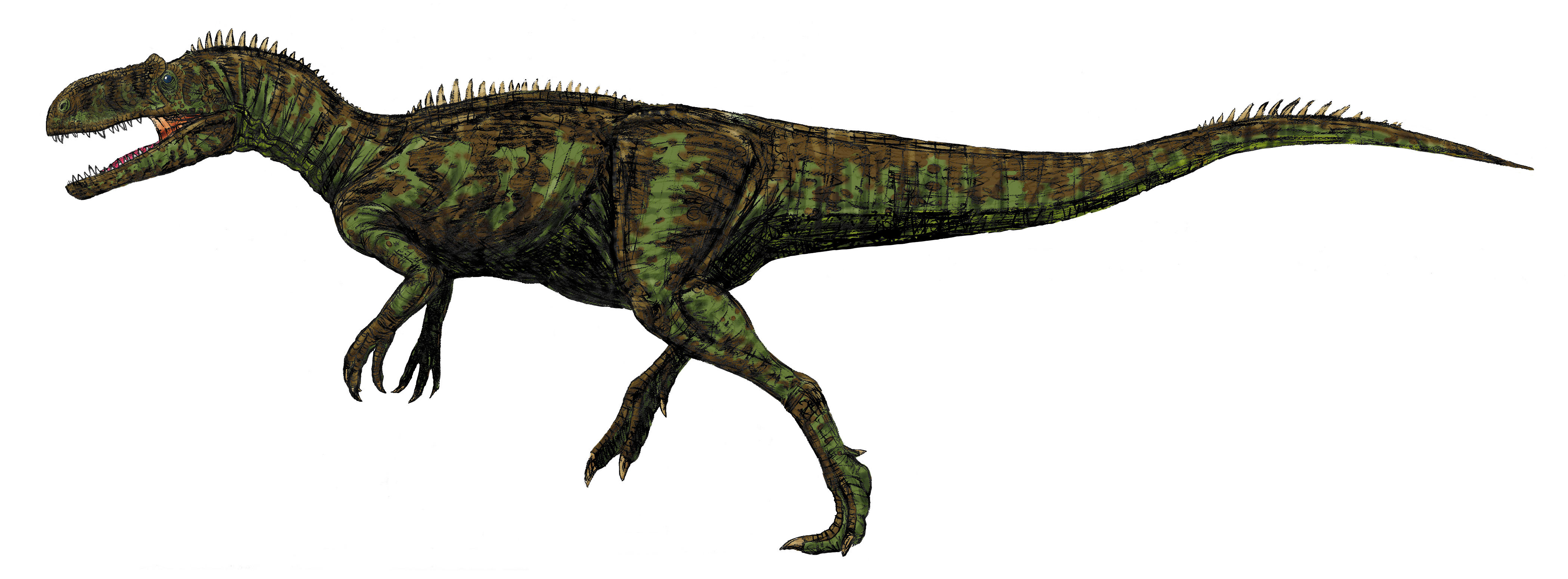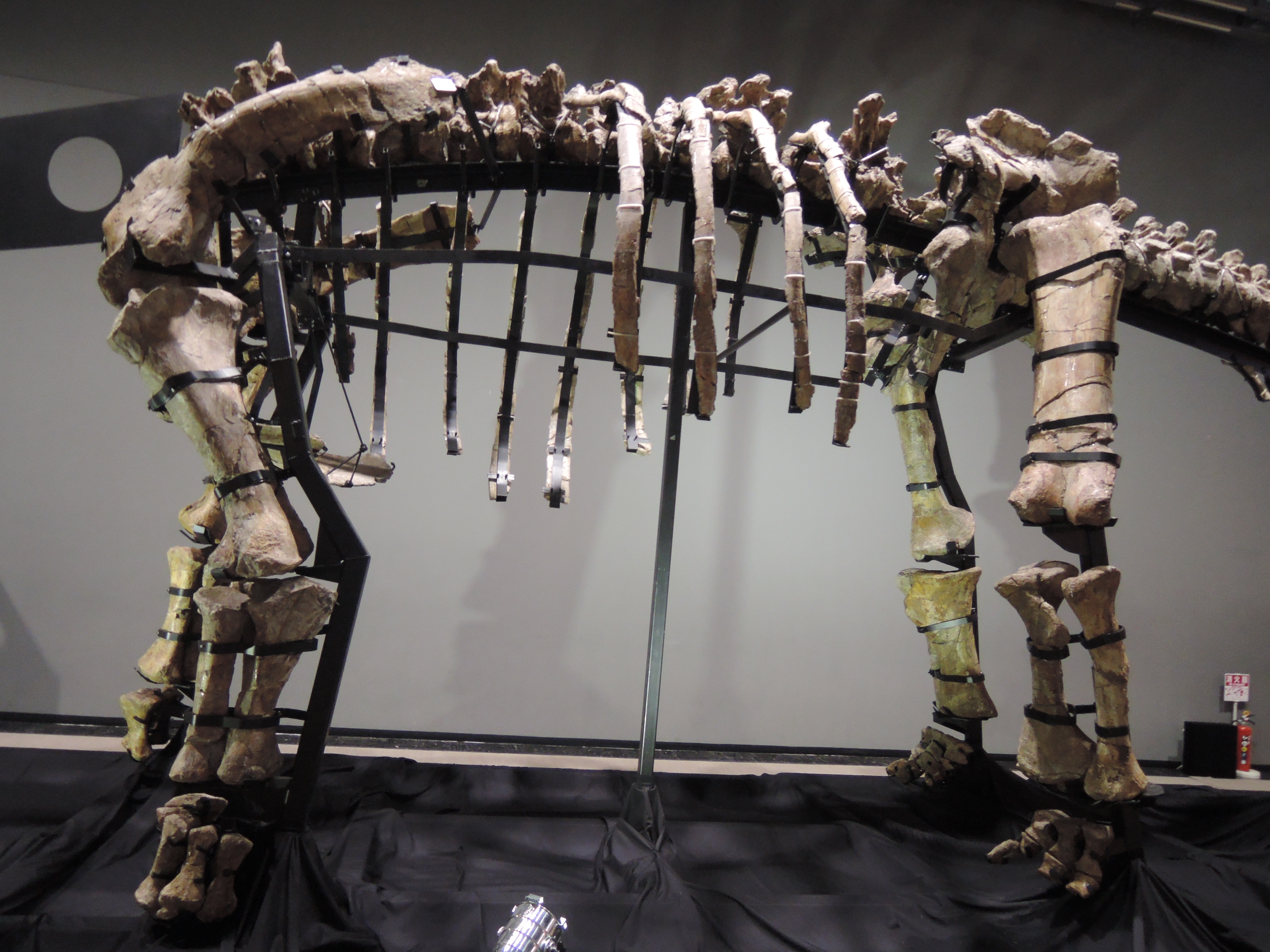|
Dongyangosaurus Sinensis
''Dongyangosaurus'' is a genus of titanosaurian sauropod dinosaur from the Late Cretaceous. The only species is ''Dongyangosaurus sinensis'', from which only a single fragmentary skeleton is known, coming from the Zhejiang province of eastern China. It was described and named by Lü Junchang and colleagues. Like other sauropods, ''Dongyangosaurus'' would have been a large quadrupedal herbivore. Description The only skeleton (holotype DYM 04888) is stored in the Dongyang Museum ( Dongyang, Zhejiang). It consists of ten dorsal vertebrae, the sacrum, two caudal vertebrae as well as the complete pelvis. The skeleton was found articulated. ''Dongyangosaurus'' was a midsized sauropod, measuring approximately 50 ft (15 m) in length and 15 ft (5 m) in height. The dorsal vertebrae were characterized by eye shaped pleurocoels and low bifurcated neural spines. The sacrum consisted of six fused sacral vertebrae, a feature unique to somphospondylans. The caudal vertebrae were a ... [...More Info...] [...Related Items...] OR: [Wikipedia] [Google] [Baidu] |
Late Cretaceous
The Late Cretaceous (100.5–66 Ma) is the younger of two epochs into which the Cretaceous Period is divided in the geologic time scale. Rock strata from this epoch form the Upper Cretaceous Series. The Cretaceous is named after ''creta'', the Latin word for the white limestone known as chalk. The chalk of northern France and the white cliffs of south-eastern England date from the Cretaceous Period. Climate During the Late Cretaceous, the climate was warmer than present, although throughout the period a cooling trend is evident. The tropics became restricted to equatorial regions and northern latitudes experienced markedly more seasonal climatic conditions. Geography Due to plate tectonics, the Americas were gradually moving westward, causing the Atlantic Ocean to expand. The Western Interior Seaway divided North America into eastern and western halves; Appalachia and Laramidia. India maintained a northward course towards Asia. In the Southern Hemisphere, Australia a ... [...More Info...] [...Related Items...] OR: [Wikipedia] [Google] [Baidu] |
Ischium
The ischium () forms the lower and back region of the hip bone (''os coxae''). Situated below the and behind the pubis, it is one of three regions whose fusion creates the coxal bone. The superior portion of this region forms approximately one-third of the |
Chaochuan Formation
The Chaochuan Formation is a geologic formation in China (Zhejiang Province). It is made up of purplish red calcarenaceous, muddy siltstone, fine-grained sandstone with interbeds of tuffaceous sandstone and conglomerate or rhyolitic tuff. Fossil content The following fossils were reported from the formation: * '' Dongyangopelta yangyanensis'' * Therizinosauridae indet. (once known as "Chilantaisaurus ''Chilantaisaurus'' (" lizard") is a genus of large theropod dinosaur, possibly a neovenatorid or a primitive coelurosaur, from the Late Cretaceous Ulansuhai Formation of China (Turonian age, about 92 million years ago). The type species, ''C ..." ''zheziangensis'') * '' Zhejiangosaurus lishuiensis''Lü Junchang; JIN Xingsheng; SHENG Yiming; LI Yihong; WANG Guoping; Yoichi AZUMA (2007). "New nodosaurid dinosaur from the Late Cretaceous of Lishui, Zhejiang Province, China". ''Acta Geologica Sinica'' (English ed.). 81 (3): 344–350. doi:10.1111/j.1755-6724.2007.tb00958.x. Re ... [...More Info...] [...Related Items...] OR: [Wikipedia] [Google] [Baidu] |
Zhejiangosaurus
''Zhejiangosaurus'' (meaning "Zhejiang lizard") is an extinct genus of ankylosaurian dinosaur from the Upper Cretaceous ( Cenomanian stage) of Zhejiang, eastern China. It was first named by a group of Chinese authors Lü Junchang, Jin Xingsheng, Sheng Yiming and Li Yihong in 2007 and the type species is ''Zhejiangosaurus lishuiensis'' ("from Lishui", where the fossil was found). It has no diagnostic features, and thus is a ''nomen dubium''. Description ''Zhejiangosaurus'' could grow up to 4.5 m (17 ft) in length and was 1.4 metric tons in weigh. Material Material for ''Zhejiangosaurus'' consists of the holotype, ZNHM M8718, a partial skeleton which has preserved a sacrum with eight vertebrae, a complete right ilium and partial left ilium, a complete right pubis, the proximal end of the right ischium, two complete hindlimbs, fourteen caudal vertebrae, and some unidentified bones. These remains come from Liancheng, in the Chinese administrative unit of Lishui on the provin ... [...More Info...] [...Related Items...] OR: [Wikipedia] [Google] [Baidu] |
Therizinosauridae
Therizinosauridae (meaning 'scythe lizards')Translated paper is a family of derived (advanced) therizinosauroid whose fossil remains have been found in mostly boundary. Even though representative fossils have only been found throughout and North America, the range of ... [...More Info...] [...Related Items...] OR: [Wikipedia] [Google] [Baidu] |
Chilantaisaurus
''Chilantaisaurus'' (" lizard") is a genus of large theropod dinosaur, possibly a neovenatorid or a primitive coelurosaur, from the Late Cretaceous Ulansuhai Formation of China (Turonian age, about 92 million years ago). The type species, ''C. tashuikouensis'', was described by Hu in 1964. Description ''Chilantaisaurus'' was a large theropod, estimated as weighing between and . In 2010, Brusatte et al. estimated it to weigh , based on femur length measurements. However, considering that greater femoral circumference indicates the greater capacity to withstand greater locomotor loads (not greater body mass), the 2020 study moderated the body mass of the holotype at . It is estimated to be around to long. Classification Hu considered ''Chilantaisaurus'' to be a carnosaur related to ''Allosaurus'', though some subsequent studies suggested that it may be a spinosauroid, possibly a primitive member of the spinosaurid family (Sereno, 1998; Chure, 2000; Rauhut, 2001) because ... [...More Info...] [...Related Items...] OR: [Wikipedia] [Google] [Baidu] |
Theropod
Theropoda (; ), whose members are known as theropods, is a dinosaur clade that is characterized by hollow bones and three toes and claws on each limb. Theropods are generally classed as a group of saurischian dinosaurs. They were ancestrally carnivorous, although a number of theropod groups evolved to become herbivores and omnivores. Theropods first appeared during the Carnian age of the late Triassic period 231.4 million years ago ( Ma) and included all the large terrestrial carnivores from the Early Jurassic until at least the close of the Cretaceous, about 66 Ma. In the Jurassic, birds evolved from small specialized coelurosaurian theropods, and are today represented by about 10,500 living species. Biology Diet and teeth Theropods exhibit a wide range of diets, from insectivores to herbivores and carnivores. Strict carnivory has always been considered the ancestral diet for theropods as a group, and a wider variety of diets was historically considered a ch ... [...More Info...] [...Related Items...] OR: [Wikipedia] [Google] [Baidu] |
Jinhua Formation
The Jinhua Formation () is a geological formation in Zhejiang, China, whose strata date back to the Late Cretaceous period (Turonian to Coniacian). It was initially believed to be Early Cretaceous (late Albian) in age.Feng Tang, Xi-Min Kang, Xing-Sheng Jin, Feng Wei, Wei-Tang Wu (2001"A New Sauropod Dinosaur of Cretaceous From Jiangshan, Zhejiang Province"in: ''Vertebrata PalAsiatica.'' Bd. 39, Nr. 4, pp. 272–281. Dinosaur remains are among the fossils that have been recovered from the formation.Weishampel, David B; et al. (2004). "Dinosaur distribution (Early Cretaceous, Asia)." In: Weishampel, David B.; Dodson, Peter; and Osmólska, Halszka (eds.): The Dinosauria, 2nd, Berkeley: University of California Press. Pp. 563-570. . Fossil content * '' Jiangshanosaurus lixianensis'' - "Partial postcranial skeleton.""Table 13.1," in Weishampel, et al. (2004). Page 269. See also * List of dinosaur-bearing rock formations This list of dinosaur-bearing rock formations is a list of ... [...More Info...] [...Related Items...] OR: [Wikipedia] [Google] [Baidu] |
Jiangshanosaurus
''Jiangshanosaurus'' is a genus of herbivorous titanosauriform sauropod dinosaur that lived in China approximately 92-88 million years ago, during the Turonian-Coniacian stage of the Late Cretaceous. Discovery and naming In 1977 and 1978 a sauropod skeleton was excavated by paleontologists Wei Feng, Wu Weitang and Kang Ximin in the Jinhua Formation of Lixian Village, Jiangshan county, in the eastern Chinese province of Zhejiang. The type and only named species, ''Jiangshanosaurus lixianensis'', was formally described by Tang Feng, Kang, Jin Xingsheng, Wei and Wu in 2001. The holotype, ZNM M1322, of ''J.lixianensis'' includes elements of the left shoulder, five back vertebrae, three tail vertebrae, the pubic bones, the ischia, and a left femur.Feng Tang, Xi-Min Kang, Xing-Sheng Jin, Feng Wei, Wei-Tang Wu (2001"A New Sauropod Dinosaur of Cretaceous From Jiangshan, Zhejiang Province"in: ''Vertebrata PalAsiatica.'' Bd. 39, Nr. 4, pp. 272–281. The genus name refers to Jiangsh ... [...More Info...] [...Related Items...] OR: [Wikipedia] [Google] [Baidu] |
Lithostrotia
Lithostrotia is a clade of derived titanosaur sauropods that lived during the Early Cretaceous and Late Cretaceous. The group was defined by Upchurch ''et al.'' in 2004 as the most recent common ancestor of '' Malawisaurus'' and '' Saltasaurus'' and all the descendants of that ancestor. Lithostrotia is derived from the Ancient Greek , meaning "inlaid with stones", referring to the fact that many known lithostrotians are preserved with osteoderms. However, osteoderms are not a distinguishing feature of the group, as the two noted by Unchurch ''et al.'' include caudal vertebrae with strongly concave front faces (procoely), although the farthest vertebrae are not procoelous. History of research In 1895, Richard Lydekker named the family Titanosauridae to summarize sauropods with procoelous (concave on the front) caudal vertebrae. The name Titanosauridae has since been widely used, and was defined by Salgado and colleagues (1997), Gonzalaz-Riga (2003), and Salgado (2003) as a node- ... [...More Info...] [...Related Items...] OR: [Wikipedia] [Google] [Baidu] |
Opisthocoelicaudia
''Opisthocoelicaudia'' is a genus of sauropod dinosaur of the Late Cretaceous Period discovered in the Gobi Desert of Mongolia. The type species is ''Opisthocoelicaudia skarzynskii''. A well-preserved skeleton lacking only the head and neck was unearthed in 1965 by Polish and Mongolian scientists, making ''Opisthocoelicaudia'' one of the best known sauropods from the Late Cretaceous. Tooth marks on this skeleton indicate that large carnivorous dinosaurs had fed on the carcass and possibly had carried away the now-missing parts. To date, only two additional, much less complete specimens are known, including part of a shoulder and a fragmentary tail. A relatively small sauropod, ''Opisthocoelicaudia'' measured about in length. Like other sauropods, it would have been characterised by a small head sitting on a very long neck and a barrel shaped trunk carried by four column-like legs. The name ''Opisthocoelicaudia'' means "posterior cavity tail", alluding to the unusual, opisthocoe ... [...More Info...] [...Related Items...] OR: [Wikipedia] [Google] [Baidu] |
Mongolia
Mongolia; Mongolian script: , , ; lit. "Mongol Nation" or "State of Mongolia" () is a landlocked country in East Asia, bordered by Russia to the north and China to the south. It covers an area of , with a population of just 3.3 million, making it the world's most sparsely populated sovereign nation. Mongolia is the world's largest landlocked country that does not border a closed sea, and much of its area is covered by grassy steppe, with mountains to the north and west and the Gobi Desert to the south. Ulaanbaatar, the capital and largest city, is home to roughly half of the country's population. The territory of modern-day Mongolia has been ruled by various nomadic empires, including the Xiongnu, the Xianbei, the Rouran, the First Turkic Khaganate, and others. In 1206, Genghis Khan founded the Mongol Empire, which became the largest contiguous land empire in history. His grandson Kublai Khan conquered China proper and established the Yuan dynasty. After the c ... [...More Info...] [...Related Items...] OR: [Wikipedia] [Google] [Baidu] |





